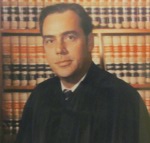
Judge Comiskey was born in New Orleans, Louisiana, on October 16, 1926. A lifelong resident of New Orleans, Judge Comiskey graduated from Jesuit High School. He interrupted his studies at Loyola University New Orleans to serve in the United States Army during World War II from 1944 to 1946. He earned a B.A. from Loyola University New Orleans in 1949 and graduated from that university's law school in 1951. Judge Comiskey practiced law in New Orleans until he received his judicial appointment in 1971. In 1961, Judge Comiskey was elected to an at-large seat on the New Orleans City Council, and he ran for mayor in 1962.
Judge Comiskey left a legacy of civic involvement and devotion to his community. As Mike Fitzpartick, one of his early law clerks, said, "Comiskey was a teacher and a gentleman. Can you imagine being out of law school, working in beautiful surroundings in the French Quarter and clerking for Judge Comiskey? It was like heaven."
Judge Comiskey was a member of the Loyola University board of trustees. In 1997, he received Loyola Law School's St. Ives Award for his service to the school. In 1999, he and his wife received the Loyola Alumni Association's Adjutor Hominum award, which honors Loyola alumni whose lives exemplify moral character and integrity.
Judge Comiskey also served as secretary of the Louisiana Bar Foundation and a member of the New Orleans Legal Aid Corporation. He was on the boards of the Bank of the South in Metairie, Fidelity Bank & Trust Company in Slidell, and First American Bank of Tangipahoa Parish. Judge Comiskey was the president of the Louisiana Bankers Association from 1985 to 1986. Further, Judge Comiskey was president of the Hermes Carnival organization; president of the Ancient Order of Hibernians; a founding member of the St. Thomas More Catholic Lawyers Association; a board member of the Christian Brothers Foundation; a board member of the Friends of St. Alphonsus Art and Cultural Center; a parishioner of St. Patrick Catholic Church; and a founding member of the Catholic Charities Association. In 1989, he was named a Knight of St. Gregory by Pope John Paul II.
Upon his death in 2005, the New Orleans Chapter of the Federal Bar Association published a tribute to Judge Comiskey. The tribute, which was written by Henry Klein and published in the Advocate, set forth Judge Comiskey's legacy of civic involvement and devotion to his community. According to the article, Judge Comiskey would often tell the following story of Mandeville Detiege to all who would listen:
"Do you see that shelter?" he would ask, pointing to a bus shelter at the front of the (City) park no more than one hundred yards from the former location of the statue of Civil War General G.T. Beauregard mounted high on a horse. "Just after the war, a black soldier in full winter uniform was looking for shade on an extremely hot day," Comiskey would recount (with feeling) to whoever was walking in the area.
The black soldier's name was Mandeville Detiege, and he had just finished serving his country in the war. As he took refuge under an oak tree in City Park, he was arrested and imprisoned for being in City Park, a prohibited area for Negroes simply because of their race and color. Judge Comiskey would shake his head in disbelief and ask, "Can you believe what we did to these people?" Eventually Deteige hired Civil Rights activist A.P. Tureaud and in 1958 Judge J. Skelly Wright enjoined the City from "...denying Negroes on account of their race and color the use of park facilities..." New Orleans City Park Improvement Assoc., v. Detiege, 252 F.2d 122 (C.A. 5 1958). Soon thereafter, standing on the shoulders of Mandeville Detiege, another black citizen, Evangeline Barthe, represented by Tureaud and Earnest Morial, persuaded a three-judge panel of (Judges) Wisdom, Christenberry and Ainsworth to declare the segregation of City Park unconstitutional. So touched was Judge Comiskey by the plight of that black soldier, that in 2004, almost a half century later, he was actively campaigning to put a plaque on the sight of the oak tree to commemorate Mandeville Detiege and his arrest for seeking shade in City Park.
